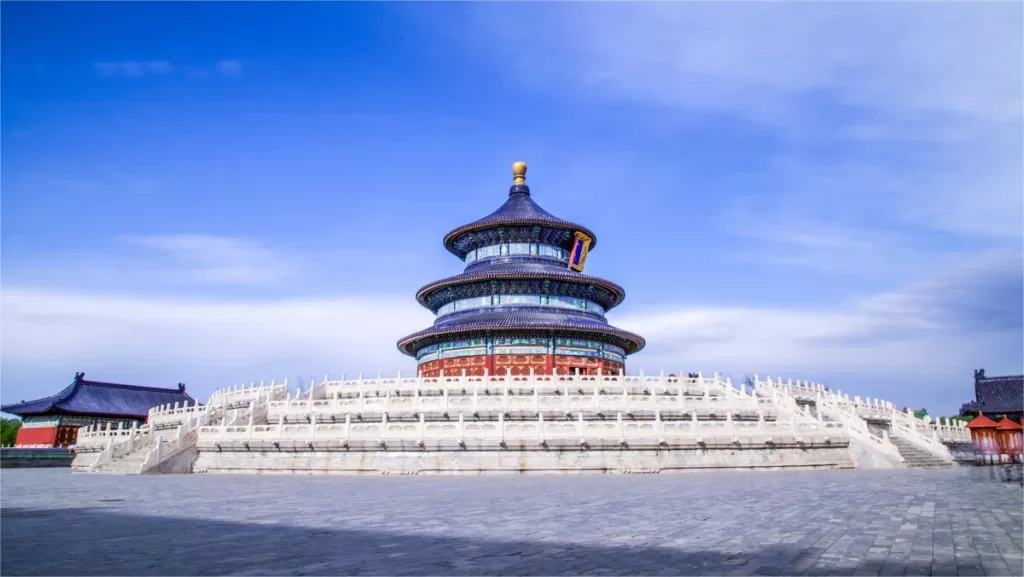The Hall of Prayer for Good Harvest (祈年殿), located in the Temple of Heaven complex in Beijing, China, is an architectural masterpiece and one of the most iconic symbols of Chinese imperial architecture. This magnificent structure is renowned for its intricate design, vibrant colors, and significant cultural and historical significance.
Historical Significance: The Temple of Heaven itself holds great historical and cultural importance. It was originally built in 1420 during the Ming Dynasty and expanded in subsequent dynasties. Emperors of the Ming and Qing dynasties would visit the temple annually to perform elaborate rituals, specifically the Heaven Worship Ceremony, to pray for good harvests and divine blessings for the country.
Location and Layout: The Hall of Prayer for Good Harvest stands at the southern end of the Temple of Heaven complex, which covers an area of approximately 2.7 square kilometers (1.04 square miles). It is situated within a vast park known as the Temple of Heaven Park, surrounded by lush gardens, trees, and scenic landscapes.
Architectural Design: The Hall of Prayer for Good Harvest is a circular building with a triple-tiered wooden structure that exemplifies traditional Chinese architectural principles. It features intricate details, exquisite craftsmanship, and symbolic elements. Here are some notable aspects:
- Exterior: The hall is constructed entirely of wood without the use of nails. The base is built with white marble, representing the earth. The upper parts are made of deep-blue-glazed tiles, symbolizing the heavens. The vibrant color contrast creates a striking visual impact.
- Triple-tiered Roof: The roof of the hall is the most visually captivating feature. It consists of three tiers, each adorned with intricate patterns, colorful paintings, and upturned eaves. The highest tier is crowned with a gilded knob, called a “Ruyi,” symbolizing good luck and prosperity.
- Pillars: Supporting the roof are 28 massive wooden pillars, arranged in four inner and twelve outer columns. The four inner columns represent the four seasons, while the twelve outer columns represent the twelve months of the year. The entire structure reflects the Chinese belief in the harmonious relationship between heaven and earth.
Interior Design: While the exterior of the Hall of Prayer for Good Harvest is awe-inspiring, the interior is relatively simple. The main focus of the hall’s interior is the highly ornate and beautifully painted central pillar, known as the “Dragon and Phoenix Pillar.” It represents the unity of the emperor, who was considered the “Son of Heaven,” with heaven and earth.
Symbolism and Meaning: The Hall of Prayer for Good Harvest carries profound symbolism and reflects the ancient Chinese philosophy and worldview. The circular shape represents heaven, while the square-shaped base represents earth, symbolizing the harmonious relationship between heaven and earth. The overall design embodies the emperor’s role as the mediator between heaven and earth, responsible for ensuring prosperity and agricultural abundance for the people.
Cultural Importance: Recognizing its architectural and cultural significance, the Hall of Prayer for Good Harvest was listed as a UNESCO World Heritage Site in 1998. It has become an iconic symbol of Beijing and an integral part of Chinese cultural identity.
Visiting the Hall of Prayer for Good Harvest offers a glimpse into China’s rich history, imperial rituals, and architectural brilliance. Its grandeur, combined with the surrounding natural beauty of the Temple of Heaven Park, makes it a must-visit destination for locals and tourists alike, showcasing the cultural legacy of ancient China.

